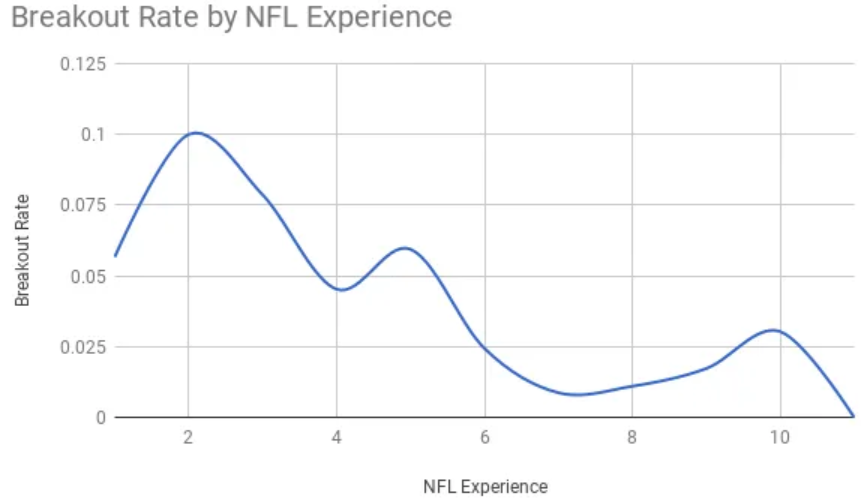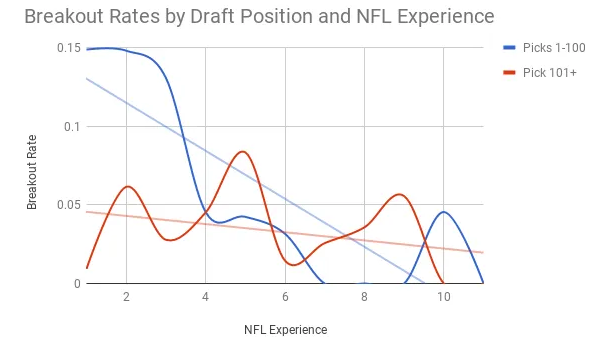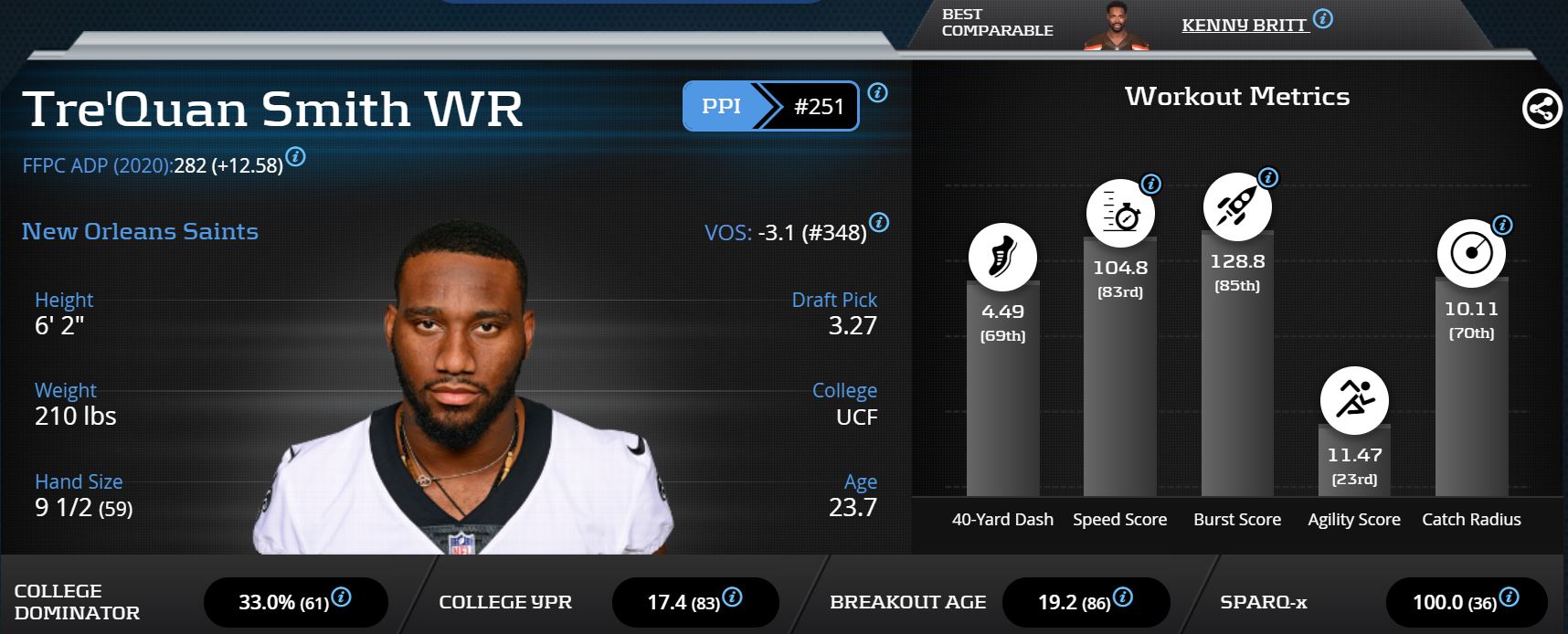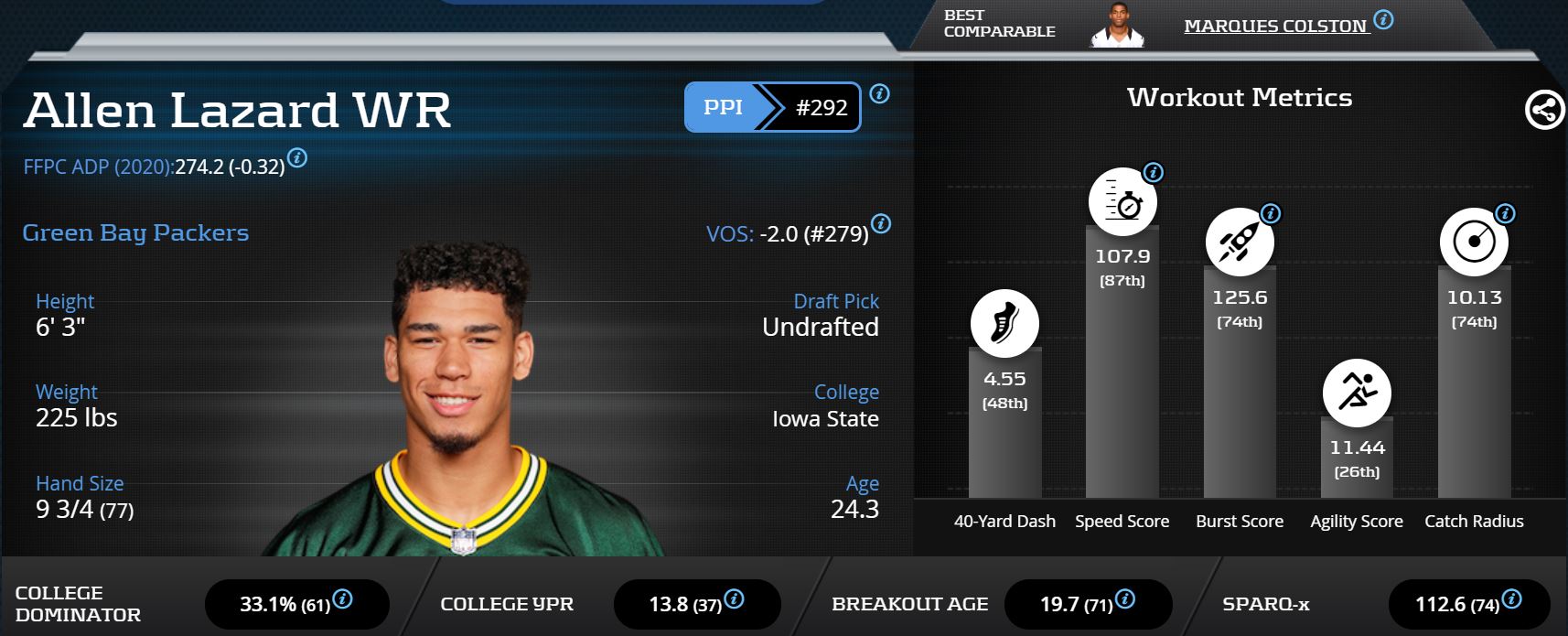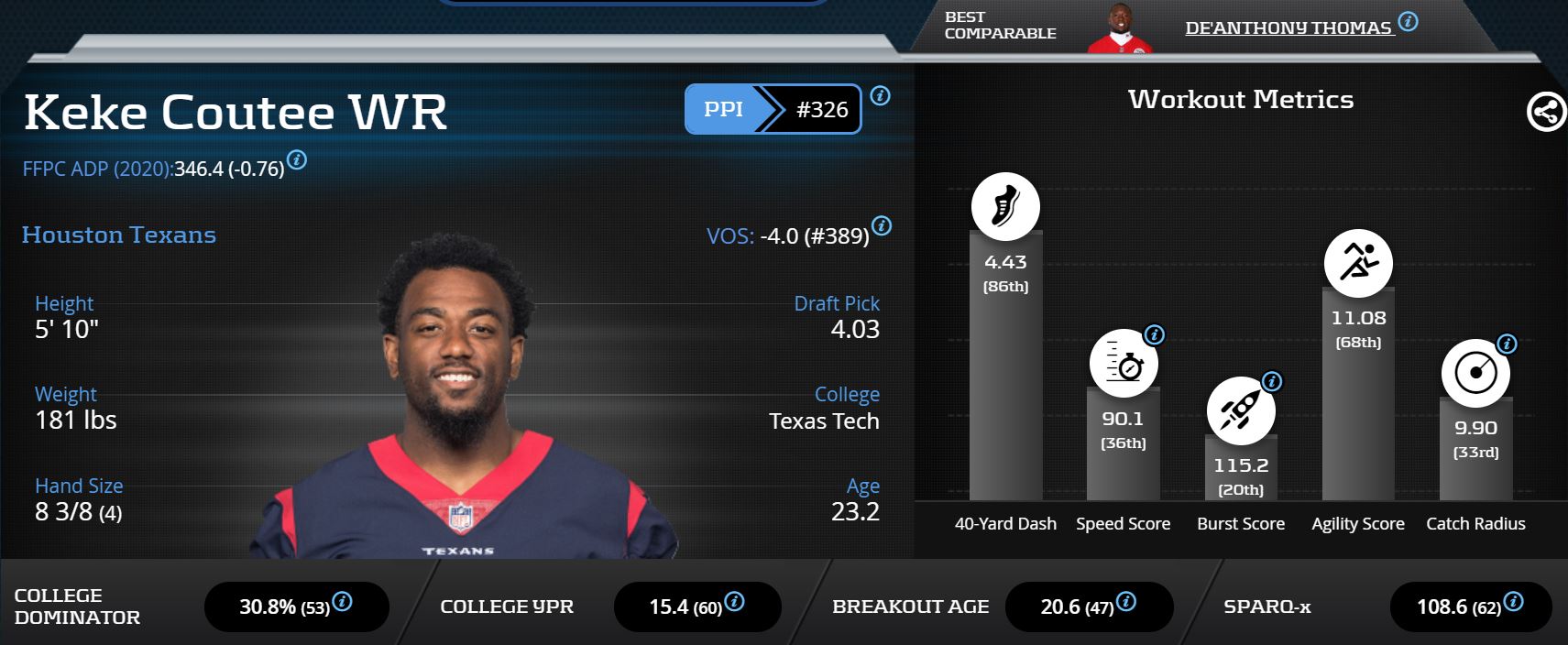I’ve made an effort this offseason to develop a more comprehensive, metrics-based methodology for analyzing players in dynasty leagues. Some of the more notable features of my offseason model:
- Using metrics that have a predictive value for future production. The quality of the metrics used takes precedence over the quantity of metrics used (Keep it simple, stupid).
- Using databases that can automatically be converted to a spreadsheet format. The abundance of data included in Playerprofiler’s Data Analysis Tool combined with its ease of manipulation makes it a worthwhile investment.
- Incorporating publicly available and free data, when appropriate. Josh Hermsmeyer’s Air Yards/RACR and Mizelle ADP Utility databases are useful resources.
Players that have historically broken out were analyzed separately from those who have not. I used at least one career top-24 PPR finish and, for the 2019 rookies, a top-36 PPR finish as an arbitrary benchmark. My analysis of breakout players focuses on their NFL production over the last two years, while college production and Combine metrics are more emphasized in the non-breakout sample.
Third-Year Breakouts
Part 1 introduced the metrics being used and focused on second-year receivers primed for a 2020 breakout. Part 2 will focus on receivers entering their third season. As mentioned in Part 1, NFL breakouts become decreasingly less likely after a receiver reaches their second year.
While third-year receivers tend to break out at a lower rate than second-year receivers, they are still better bets than those with with three or more years of experience. Anecdotally, Year 3 seems to be the time when fantasy owners first start losing hope on players that haven’t broken out yet. Among the non-breakout sample analyzed, Year 2 receivers have a current average ADP of WR73, while Year 3 receivers have an average ADP of WR77. Blair Andrews’s analysis shows that receivers selected before Pick 101 in their draft are far more likely to break out in their third year than those selected with later picks.
We can use the above information and the results of my metrics model to more precisely pinpoint which receivers are most worth investing in while considering their current ADP.
Tre’Quan Smith
Tre’Quan Smith clears nearly every statistical benchmark for a breakout candidate while remaining dirt cheap. For one, he was drafted before Pick 101, landing him on the more favorable earlier pick curve for Year 3 receivers. Smith is still only 23 years old, weighs 210-pounds, has a 19.2 (86th-percentile among qualified wide receivers) Breakout Age, a two-year average of 9.55 yards per target (No. 5 of the non-breakout sample of 51) and a strong two-year 37-percent Slot Rate average.
Smith’s 2019 breakout season was derailed by an ankle injury in Week 2 that saw him miss five weeks. He still managed to score five touchdowns on 25 targets in 2019. The lack of other receiving competition combined with Drew Brees‘s return and the likely regression of Michael Thomas‘ league-leading 33.2-percent (No. 1) Target Share puts Smith in an excellent position for a 2020 coming out party. At worst, he’ll provide serviceable production at the end of fantasy benches. According to Mizelle ADP Utility, Smith is No. 103 in positional ADP as of March 2020. Buy, buy, buy.
Allen Lazard
Going undrafted in 2018 speaks less favorably to a Year 3 breakout, but Allen Lazard performs so well in the model that he’s worth highlighting anyway. NFL scouts were sorely misguided in Lazard’s pre-draft evaluation. Knowing this should contest the validity of his undrafted label. The main reasons he went undrafted were concerns about his speed, hands, and toughness. Not only does he own a 107.9 (87th-percentile) Speed Score, but weight, not speed, is actually the strongest indicator of future NFL success for receivers as it relates to Combine metrics. Lazard weighs a hefty 225 pounds. The “bad hands” trope is overstated with respect to wide receiver evaluation. A one-game sample size at the Senior Bowl is hardly enough to make any definitive confirmation. The quality of toughness in athletes is ambiguous, subjective, difficult to judge and quantify, and not confirmed to be in anyway predictive of future NFL success.
A small percentage of Lazard’s pre-draft critique may end up having validity. He had a 7.7-percent (No. 22) Drop Rate in 2019. Regardless, his strong age-adjusted college production in spite of his apparent lack of athletic and character traits, speaks to the absurdity of his going undrafted. Too bad NFL scouts generally look down upon analytics. Lazard’s 8.1 yards per target over his last 2 seasons ranks No. 16 of the non-breakout sample of 51. His 17 targets over his final two games of 2019 speaks to his ability to carve out a meaningful role in the Packers offense despite his unjustifiably low draft capital. Here is hoping, and expecting, that Lazard is an outlier in the draft pick number vs. breakout rate curve.
Keke Coutee
Certain elements of Keke Coutee‘s profile are problematic on the surface. Luckily, we can use nuance to paint a more accurate picture of his future prospects. He only weighs 181-pounds and has a two-year yards per target average of 7.05, ranking No. 37 of the 51-player non-breakout sample. Yards per target is a metric that, while useful, tends to be biased against lower ATD receivers. His 63.1-percent Slot Rate, two-year RACR average of 1.17, and 2.32 (No. 2) Target Separation mark in 2018 paints a rosier picture. Though he was routinely sequestered in Bill O Brien’s doghouse last year, and BoB doesn’t appear to be leaving Houston anytime soon, the lack of other receiving options combined with Will Fuller‘s extensive injury history bodes well for increased opportunity for Coutee in 2020.
Coutee’s youth (23 years old), fourth-round draft capital and nagging injury history should engender in Houston more patience with him than your typical Year 3 player would. When he was utilized more consistently in 2018, he owned a significant 16.0-percent (No. 16) Hog Rate. While past NFL opportunity, especially in a smaller sample size, is not included in my non-breakout model, it’s noteworthy here. His 30.8-percent (53rd-percentile) College Dominator Rating speaks further to his ability to handle a larger workload than what his smaller stature would suggest. This analysis assumes that O’Brien is rational and keeps Coutee on the 53-man roster this summer. If not, he should get at least one more opportunity with a different team. For now, he’s better off left on the waiver wire in shallower leagues and monitored this offseason. He has fallen outside the top 113 in positional ADP as of March 2020.
Keke Coutee (post-DeAndre Hopkins trade)
The Keke Coutee portion of this article was written before the announcement that the Texans were trading their star receiver DeAndre Hopkins and a fourth-round pick for David Johnson, a second-round pick and a 2021 fourth-round pick. This baffling move further confirms the notion that Bill O’Brien has a tenuous understanding of how to coach and manage an NFL franchise. Poor Deshaun Watson should look anywhere for an escape hatch.
Check out Keke Coutee on PlayerProfiler’s Updated Dynasty Rankings and Projections:
While this move appears to be suggestive of a philosophy switch to a run-heavy inclination for the Texans offense, it should be noted that Houston only ranked No. 21 in first/second down pass rate in neutral game scripts last season. Regardless, Hopkins leaves a gaping crater of opportunity that will likely be distributed among multiple players. Anecdotally, the public’s perception appears to be of Fuller and Kenny Stills being the main beneficiaries of the trade. I don’t expect Coutee to see a meaningful bump in dynasty ADP, and his chances of playing time and opportunity only increases.

